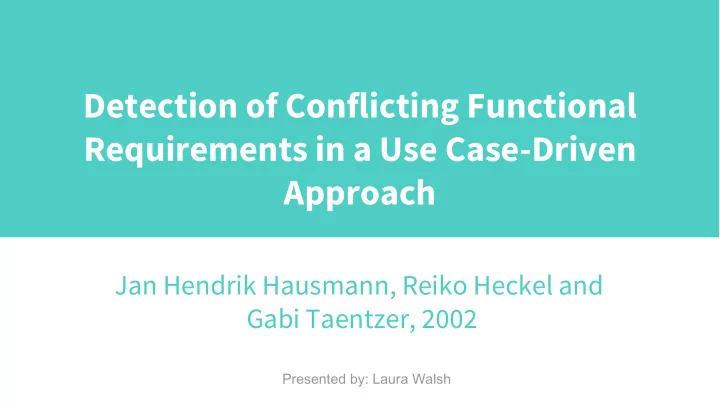

Detection of Conflicting Functional Requirements in a Use Case-Driven Approach Jan Hendrik Hausmann, Reiko Heckel and Gabi Taentzer, 2002 Presented by: Laura Walsh
Motivation Find conflicting requirements as early as possible!
Motivation
Goal - Analyse the requirements of the system before starting to build it, in order to identify whether there may be conflicting requirements - Add information to UML models which tell the modeller where there is the potential for conflicts
Types of Consistency to Maintain 1. Consistency of aspects Use cases refer to situations from the problem domain which are not represented in the static model. 2. Consistency of views Semantic overlap between use cases expressing different requirements.
Running Example Class diagram - to represent static requirements
Use case diagram- to represent dynamic requirements
Action specifications - to represent functional requirements
Rules
Representing the Model Typed graph transformation system G = <TG, C, P, π> TG = Type Graph (an abstract representation of the class diagram) C = Constraints (what is allowable in the system) P = Rule/action names π = mapping between rule names (from P) and the expression of the rule in TG
What Causes a Conflict? Parallel Independence: there can be no overlap in the items that are deleted by two transformations Sequential Independence: there can be no overlap in the items that are created by two transformations
Finding Conflicts Find all critical pairs among transformations (can be done using graph transformation system AGG)
Strengths - Simple implementation that has the potential for great improvement (of efficiency, cost cutting) to the requirements phase of software modelling - Approach allows modeller to use their own CASE tool (along with AGG tool which already exists)
Weaknesses - No study on whether their proposed additions to use case models would actually help modellers - As the class diagram grows larger and more complicated, there will be many conflicts to sort through. Is it reasonable to expect modellers to manually review each flagged potential conflict?
Final Thoughts / Questions - Small scope of the study - Which (if any) techniques have been widely adopted since this paper was published?
Discussion - How could the scope have been expanded? - What are some ways that the researchers could have conducted a study to find out if their ideas had a significant impact? - Do you think this process has the potential to be used by modellers? Why or why not?
Recommend
More recommend